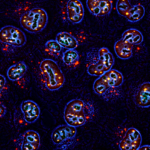Lien vers Pubmed [PMID] – 11313457
Mol. Cell. Biol. 2001 May;21(10):3314-24
The SP100 protein, together with PML, represents a major constituent of the PML-SP100 nuclear bodies (NBs). The function of these ubiquitous subnuclear structures, whose integrity is compromised in pathological situations such as acute promyelocytic leukemia (APL) or DNA virus infection, remains poorly understood. There is little evidence for the occurrence of actual physiological processes within NBs. The two NB proteins PML and SP100 are covalently modified by the ubiquitin-related SUMO-1 modifier, and recent work indicates that this modification is critical for the regulation of NB dynamics. In exploring the functional relationships between NBs and chromatin, we have shown previously that SP100 interacts with members of the HP1 family of nonhistone chromosomal proteins and that a variant SP100 cDNA encodes a high-mobility group (HMG1/2) protein. Here we report the isolation of a further cDNA, encoding the SP100C protein, that contains the PHD-bromodomain motif characteristic of chromatin proteins. We further show that TIF1alpha, a chromatin-associated factor with homology to both PML and SP100C, is also modified by SUMO-1. Finally, in vitro experiments indicate that SUMO modification of SP100 enhances the stability of SP100-HP1 complexes. Taken together, our results suggest an association of SP100 and its variants with the chromatin compartment and, further, indicate that SUMO modification may play a regulatory role in the functional interplay between the nuclear bodies and chromatin.

